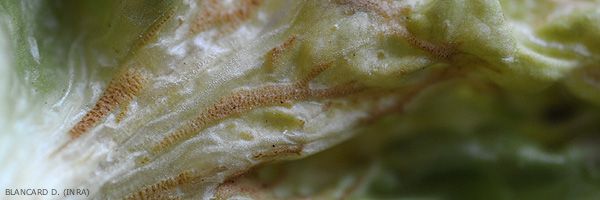
Frost damage
The tender and succulent fabrics of some salads do not tolerate low temperatures well. Following frosts , it is not uncommon to see elongated interveinal lesions appearing corresponding to the formation of ice under the epidermis. The upper surface of the leaf blade may be wrinkled, blistered (Figure 1). Below the limbus, the epidermis detaches from the underlying tissues; the affected portions of the limbus then take on a silvery appearance. Quite frequently, the epidermis ruptures and the more protected mesophyll tissues acquire an orange to brown color (Figures 2 to 4). Tissue bursts can occur along the midrib (Figure 5).
It should be noted that during winter, in greenhouses and cold tunnels, salad leaves may have a superficially "blistered" blade and a duller appearance. Technicians call this physiological condition "the toad skin" of lettuce.
Low temperatures, condensation of cold water on the leaves are the cause of these not very damaging symptoms. High salinities could be the cause of comparable damage.
In addition, at very low temperatures, below 0 ° C, salads may freeze more or less depending on the types and varieties of salads. When the temperature becomes warmer again, those that are too affected wither and collapse, giving the leaf tissue the impression of having been scalded (Figures 6 to 8). The interior of the pivot may also be affected, showing internal necrotic lesions (Figure 9).





